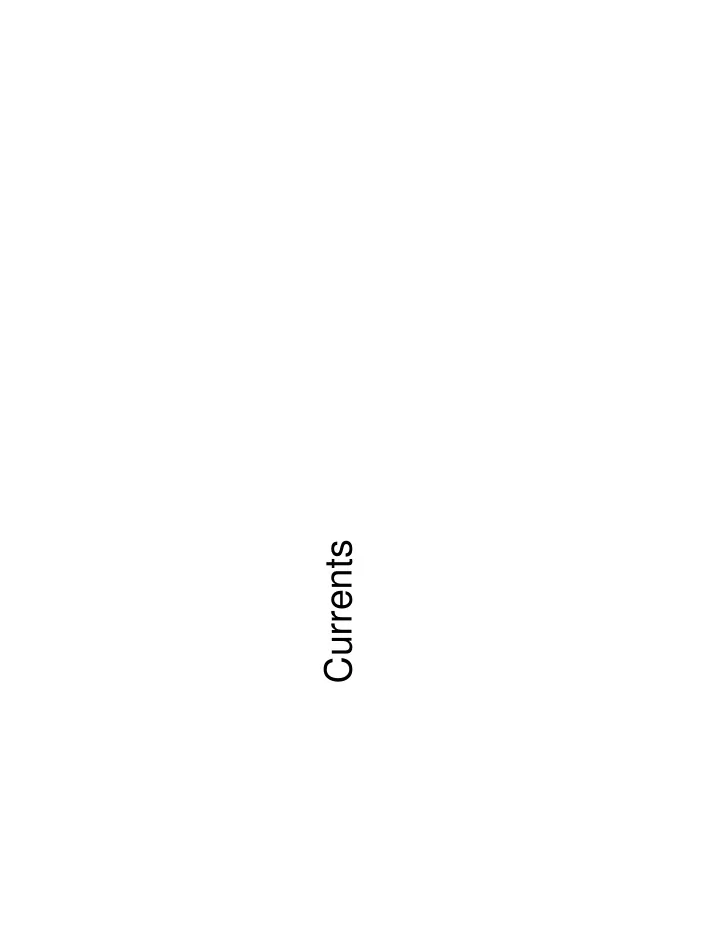

Currents
SPS Presents: A Cosmic Lunch! • Who: Dr. Brown will be speaking about “Evolution of the Elements: from Periodic table to Standard Model and Beyond”! • When: October 17 th at 11am • Where: CP ‐ 179 (by the front office) • There will be pizza and soft drinks!
Test 2 Next Wednesday (Oct 11) 1. Chapters 7, 8 (8.1-8.3). 2. You are not allowed to check your section number during the test. However, you will get 3 bonus points if you fill in your section number correctly. 3. 45 minutes sharp. 4. 4 multiple choices and 2 long problems. 5. Formula sheet provided. 6. Contact me before next Monday for prearrangement if you need special accommodation.
Currents
Current If dQ is the amount of charge passes through A in a short time interval dt, current is defined as: dQ I dt Units of current: Ampere (A) C/s I + - - + Electrically these two cases produce the same current, but they can be distinguished with a magnetic field.
Drifting velocity v d At any instant, electrons contributing to the current is moving very fast at about 10 6 m/s. They also make collision with atoms and impurities very often, about 10 14 times per second. E As a result, electrons drift very slowly along the electric field direction with a drifting velocity v d ~ 10 ‐ 4 m/s.
Microscopic Model of Current Full of electrons How many electron will pass the area A in a short time A interval dt? Empty If n is the number of electrons per unit Full of electrons volume. Number of electrons pass through area A = n volume = n(v d dt)A A If the charge of electron is e. v d dt Charge pass through area A is Empty dQ=ne(v d dt)A dQ I I nev A d dt
Class 20: Electric current and resistance, Ohm’s law
Drude’s Model Electrons collide with atoms. Let the velocity of an electron immediately after the collision be v i . Electrons will continue to accelerate in opposite direction to the electric field until the next collision. e E v v a t v v t i i m Drude’s assumption: v i is independent of the electron motion before the collision, and it has equal probability in pointing in any direction. i.e. v 0 i e E e E e E v v t v v t v t i i m m m But <v> = v d , and let <t> = , average time between collisions. 2 e E ne v j ne v E d d m m 2 ne j E if m
Current Density and Ohm’s Law (physics version) Current density I J A Ohm’s Law (physics version) 1 J E J E or J E 1. is called conductivity. Do not confuse this with the surface charge density. 2. is called resistivity. Do not confuse this with the volumetric 1 charge density. 3. and represent the same information, . 4. and are properties of materials.
Ohm’s Law (electronics version) J I and E V Ohm’s Law: 1 I 1 V J E A V I A V I R where J E J E R A 1. R is called the resistance. 2. Units of resistance is Ohm ( ). V/A
Power Power dissipated in resistance R: R I V 2 P = I V = I 2 R = R V Units of power: Watt (W) J/s
Resistance, Conductance, Resistivity, and Conductivity Ohm’s Law: 1 1 Resistivity Conductivity J E J E Units: m Units: S/m A R G A 1 R Conductance G G I Resistance R V I R V Units: Siemens (S) Units: G or mho 1. Resistivity and conductivity depend on the materials only, Resistance and conductance depend on both the materials and also the geometry of the conductor. 2. Ohm’s Law: V = IR or J = E R 3. A 1 1 and R 4. G
Resistance and Temperature For a normal conductor: As temperature rises, electrons will make collisions more frequently. As a result, decreases and hence increases. Linear approximation: - 0 [ 1 ( T - T )] 0 0 0 T - T 0 or R R [ 1 ( T - T )] 0 0 =Temperature coefficient of resistivity T 0 = 20 o C
Recommend
More recommend